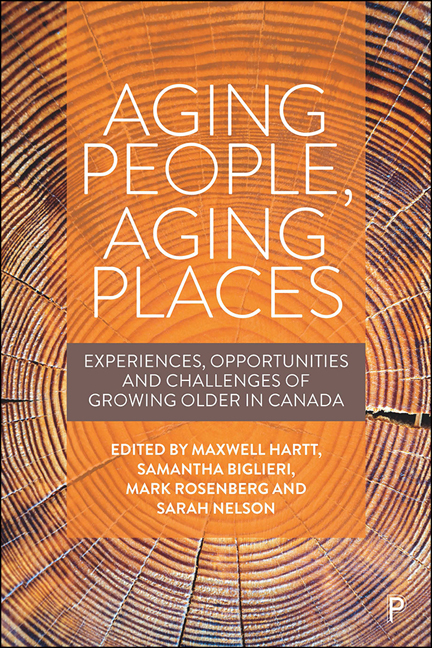Introduction
Published online by Cambridge University Press: 18 December 2021
Summary
Our world is growing older. As birth rates continue to drop, and younger residents and recent immigrants congregate in a small number of global cities, the demographic geography of Western nations has become increasing uneven (Townshend and Walker, 2015). While it is important to celebrate the fact that people are living longer and healthier, such changes in population also challenge the viability of economic and healthcare systems (Nefs et al, 2013). Canada's demographic shift is particularly significant as Canada is home to the world's largest proportion of ‘baby boomers’ – those born between 1947 and 1966 (Foot, 1999). As the baby boomers reach and pass retirement age, Canada's population pyramid will become increasingly top-heavy. The shift is already well underway. As of 2015, Canadians aged 65 years and older have outnumbered children aged 0 to 14 years (Statistics Canada, 2015).
The aging of the population has called into question how prepared national, provincial, and local governments are to support the needs of the heterogeneous older adult population. Though national- and provincial-level planning on macro-level issues like pensions and healthcare is commonplace, these debates neglect how policies play out on the ground in the complex and varied regional milieu of a large nation like Canada (Hodge, 2008). Recent research has shown a ubiquitous increase in older adult populations across Canadian municipalities (Hartt and Biglieri, 2018). Of course, an increase in the older adult population is not problematic in its own right. More concerning is that the Canadian cities expected to age the most are also the least likely to have begun any age-friendly planning (Hartt and Biglieri, 2018). In order to prepare for this demographic shift, we need a better understanding of the local implications of aging and the built environment's impact on the health and wellbeing of older adults.
The importance of the local environment is reflected in the overwhelming desire of older adults to maintain their independence as they age, often expressed as the desire to age in place (Hodge, 2008). As people age, they are increasingly likely to experience some kind of impairment (physical, sensory, or cognitive) or reduced mobility (Myers et al, 2005).
- Type
- Chapter
- Information
- Aging People, Aging PlacesExperiences, Opportunities and Challenges of Growing Older in Canada, pp. 1 - 12Publisher: Bristol University PressPrint publication year: 2021



